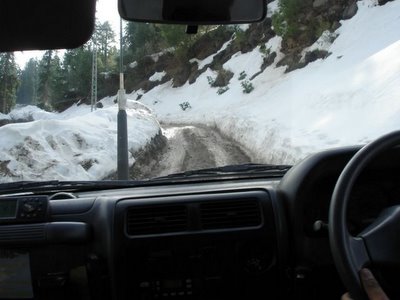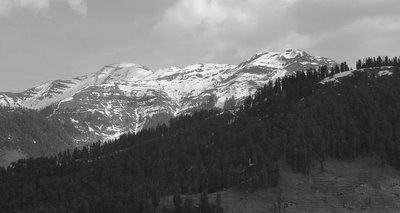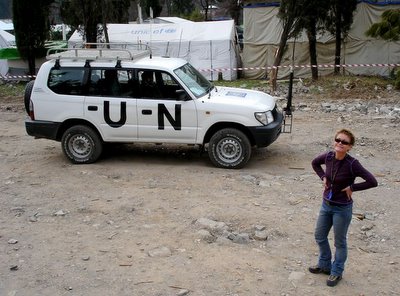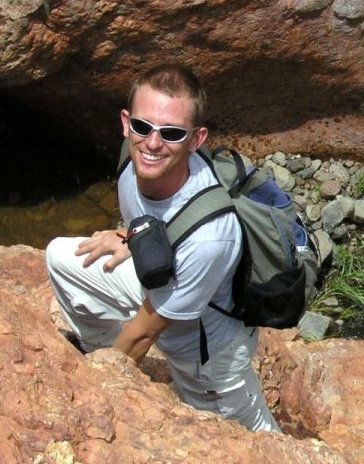I won't get the whole blog written from here, but at the moment I'm in a tent in the UN camp in the town of Bagh. The town is about 15 km from the Line of Control that separates India from Pakistan in the disputed territory of Kashmir. It's a pretty big town. I'm guessing something like 20,000 people live here. It mainly consists of two narrow streets lined with densely packed two and three story buildings. It's strung along a hillside above a wide floodplain which at the moment only has a small river braiding it's way among the huge boulders brought down by past floods.

The town of Bagh suffered heavy damage from the magnitude 7.6 quake on October 8.

The town of Dhulli, near Bagh, is typical of small towns in Kashmir.
I came up here to do more GPS training with UN staff who will use the GPS kits we supply to collect data on the roads (for you GIS geeks out there - we are using Garmin GPS Vs to collect a combination of tracks and waypoints to define and attribute the road; clumsy, but it works and is cheap). Thankfully for me, that means getting out into the field and driving some roads. Bagh sits at 1100m (3600 ft) and traveled up and over a 2750m (9000 ft) pass into the adjacent valley. The windy road was a paved single lane most of the way, in pretty good condition. Although the winter has been mild, there is still a couple of feet of snow in the pass.

The road to Bandi Abbaspur. The roads are kept clear by a combination of Pakistani military and civil authorities, but UN Ops has a team that tries to fill in the gaps. Funny how, when you get high enough, all mountains look the same. This could be California.

A view of the mountains through a ruined building. The roof behind is sitting on the ground.

These are just the small peaks. This one is no more than 12,000 feet high. The huge Karakorum range to the north has several peaks over 26,000 feet.

A view of the Kharakorum. The large one ascending into the weird pink haze on the right is Nanga Parbat (I think), supposedly the most difficult mountain climb in the world, or so they say. The houses are sprinkled on the foothills like salt. It's a remote place, but densely populated.
On the way up, we passed a UN Operations team with snow clearing equipment. A couple of French Canadians fresh from Afghanistan, they were planning to camp up there for a few days and work to clear an important road of the snow that is blocking it. They have snowmobiles for getting around and surveying the route. Where do I sign up? The road they are clearing is one for which our data is poor, so I gave them a quick training and a GPS unit.
Unfortunately, they only got one night up there. For the next couple of days there were significant protests in other parts of Pakistan over the Mohammed cartoons. Although Bagh is pretty mellow and there haven't been any protests so far, the camp is run by Norwegians, so they pulled all the foreigners back to the base camp for a couple of days. In Bagh, most foreign aid workers who are women don't cover their hair. It doesn't seem to cause any problems. Although driving around with Susie, a spiky-haired fireball of a woman from Australia, I did see the absolute amazement on the faces of people we passed. She could have had tentacles coming out of her ears for the looks she got. They just didn't quite know what to make of her, though it never seemed angry or reproachful.

UNJLC field officer, Susie Busch, has been working in Bagh for several months.

The UN camp in Bagh. About 15 people sleep in each tent, inside little canvas enclosures that give a bit of privacy. You can hear everything anyone does, though, from opening a candy bar in the middle of the night to (of course) snoring. I swear at one point it sounded like a chorus of frogs on a summer's evening. Earplugs help. There's wireless internet throughout the camp, which is good for posting blogs.

The camp latrine. I'm not kidding. Just for guys pissing, though. There's a proper latrine for when you need to sit down. When it's really cold, you have to be careful that your bits don't touch the metal pipe or you might end up in a tongue-on-the-flagpole situation.
The next day brought rain (and some more snow up high). Another training drive took us up a canyon near Bagh on a road that doesn't appear on our maps at all. The road came to an abrupt halt at an area of massive landslides.

Whole mountain sides have come down, not just covering the road, but obliterating it. This picture doesn't even begin to capture the scale of the thing. It wouldn't fit in the frame. It was one of the most impressive things I've ever seen.

A small bridge barely hangs on to the side of the canyon. The American Rescue Council, an NGO, works in this valley. The head of the operation here told me that all the aid that had gone to towns above the slide had gone on foot, one person at a time, across this bridge and across the very precarious trails stamped into the mud of the slide on the other side.
Damage from the earthquake is evident everywhere. In town, some buildings collapsed leaving rubble filled holes between their neighbors. Outside of town, collapsed houses are everywhere.

Many buildings came down, but many more were left standing but damaged. The next quake won't have to be so big to cause major damage to the already weakened buildings. Some NGOs are bringing in earthquake engineers to assist in mitigating this threat, but that's a task that will take many years.

Even the mosque was not spared.
Working and traveling in the very different cultures that I have in the last couple of years, I've noticed that in many ways they aren't that different. People still want the same basic things, a comfortable and secure life, to feel productive, to feel some sense of self-worth. But sometimes you see something that makes you realize just how wide the span of human experience really is. I've seen women here, fully covered but for their eyes, turn their backs to the road and squat down as we pass in the car, so strong is the taboo on being seen by a male stranger. Another example is the profusion of homemade helipads. Noting that helicopters tend to land on white H's marked on the ground, locals have started making their own in hopes that a heli will plop down and disgorge lots of stuff.

This homemade helipad is on someone's house and I don't think they would be very happy if a big white MI-8 tried to land on it.
